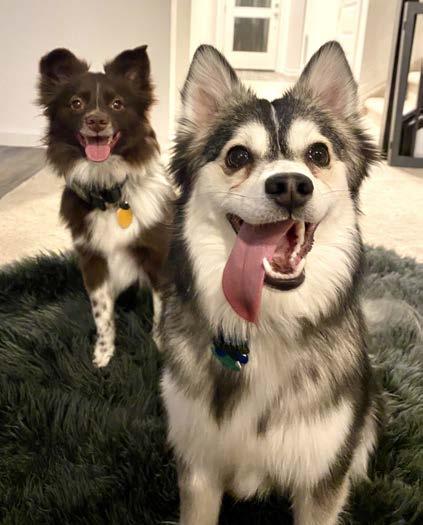
7 minute read
Broomfield’s Pet for the Ages: Shep the Turnpike Dog
By Megan Mayes
We love our family pets dearly and we have a great appreciation for wild critters in our beautiful mountain state. Could we show the same love to a dirty homeless mutt found at an inconvenient time and place? Almost 70 years ago, Broomfield residents did just that when Shep the Turnpike Dog was adopted by tollbooth workers and cared for by drivers stopping to pay their tolls. He became a familiar and friendly face for many commuters and families passing by, and eventually a well recognized member of both the Broomfield Community and the Colorado Department of Transportation.
In 1950 the Denver-Boulder Turnpike was being built and Broomfield was chosen as an approximate halfway point between the state capital and the growing college town. This toll road is what we now know to be Highway 36. During the construction of the Broomfield toll booths, a stray dog was often seen walking around the site, begging for food from the workers’ lunches. Even after construction was complete, the dog would visit the toll booths, and eventually an attendant was able to befriend him and bring him into the booth. This is the beginning of Shep’s story and his journey to become The Turnpike Dog of Broomfield.
Shep was adopted by the toll booth attendants, and named for his shepherdlike appearance. He would keep the attendants company during their long and lonely shifts. Shep also greeted the toll road drivers as they paid their fares. People would look forward to seeing the dog in the booth, and would even stop their cars to take a picture with him on occasion. As his reputation grew, motorists would bring him gifts or make donations to the toll attendants for his food and toys. He was well known and well loved during his time on the turnpike.
Shep lived at the toll booth for 14 years, where he grew from a puppy to a dog. As he aged, Clyde Brunner donated his veterinary expertise to care for Shep. In 1964, Shep was put to sleep. He was buried near the toll booth, and local vendors supplied two headstones and fencing to mark his grave. He was remembered as “part shepherd, mostly affection.” For years to come, Broomfield residents would visit him there and decorate his burial site with flags, flowers, and toys. Shep could be seen there even when the toll booths were gone and the turnpike became a busy highway.

Charlotte Havey was touched by Shep’s story while filming a documentary about Broomfield’s 50th anniversary. She decided to share the story of canine and community with children through a picture book called “Shep the Turnpike Dog.” The love of the Broomfield residents for a stray dog is at the core of Shep’s story. Among them she recalled, “One day, a driver gave a can of dog food to the toll booth operator who thanked the driver but admitted he didn’t have a can opener. The next day the same driver gifted an opener!” Charlotte used her book to show us how the unconditional love of a dog can bring out the best qualities in the humans that receive it.
When construction began on the Wadsworth interchange, it was time to bring Shep to a safe and accessible final resting place. His grave and original headstones can now be found at Zang Spur Park next to the Broomfield Depot Museum. Many pet owners and furry friends still visit Shep to remember the legacy of Broomfield’s first celebrity.

When the Unexpected Happens,
MAKE SURE YOU AND YOUR PETS ARE READY By Kristen Beckman

ARCHIE Submitted by Chase Alexander
If 2020 has taught us anything, it is that it is important to be prepared for the unexpected. An unprecedented situation like COVID-19 highlights the need to think ahead and have critical supplies in place to sustain your family and your pets in case supplies are temporarily limited, stores are closed or you are unable to leave home due to a quarantine.
Large forest fires in the mountains late this summer and into the fall have also put a spotlight on the need to be prepared, in this case to leave your home at a moment’s notice rather than to shelter in it for weeks or months. When evacuations occur, having everything ready to go for both humans and pets can make the difference between a chaotic crisis and a smooth and safe escape for everyone.


BELLA & DENI Submitted by Max Meints

FIONNA Submitted by Cari Hemmingsen BALOO Submitted by Cari Hemmingsen
“It’s always a challenge to expect the unexpected,” said Amanda Boerman, marketing and community relations manager at the Humane Society of Boulder Valley. “Over the past several years, the most common reason people are unexpectedly displaced from their homes is due to a natural disaster - such as fire or flood. During these urgent evacuation situations, having plans and supplies in place helps make these stressful events a bit less chaotic.”
Taking steps like ensuring your pet’s microchip registrations are updated with current contact information and that they wear a collar with ID tags with your name and phone number are simple steps that can help you reunite with your pet if an emergency situation separates you. Keeping a list of pet-friendly hotels or shelters in your area can help you find a safe place for your pet to stay if necessary during an emergency.
EMMY Submitted by Barbara Lager

At the outset of the COVID-19 crisis, the Humane Society took the opportunity to educate pet owners about the steps they should take to prepare for an emergency that might impact their pets. Among the recommendations are:
Keep at least a one-month supply of your pet’s regular food on hand to ensure continuity in their nutrition during situations like the COVID-19 stay-at-home order when supplies of many staples sometimes ran short and visiting stores was often difficult. Order online to replenish supplies if necessary. In addition to food, keep adequate kitty litter on hand for your feline family members.
Make sure you have plenty of your pet’s medications, and don’t wait until you are almost out of necessary prescriptions to get a refill.
Prepare a “Go Bag” so that you or a rescuer can leave your home with your pets at a moment’s notice should it ever become necessary. Include a leash, collar with ID tags, food, toys, a blanket KAI Submitted by Claire Brunet or bed, and prescriptions. Also include a list of information about your pet, including their regular food brand, and information about prescriptions, as well as contact information for veterinarian, groomer, and regular boarding facilities.

Proactively designate a caretaker for your pets who can step in and provide care if you are unable to. Have a conversation with designated caretakers in advance about where your pet’s go bag is located, how to access your home, and important details about your pet’s care. It’s also wise to let your network of family and friends know who your pet’s designated caretaker is should they ever be needed. CocoJoe Submitted by Mike Sales

“It can be a challenge to find housing, or caretakers when in the middle of experiencing displacement from your home, or an inability to provide care,” said Boerman. “It is critical to have a plan in place for your pet so that you can seek the support you need, to alleviate the fear of severing your relationship with your pet!”
The Humane Society can help with finding care for your pet should you be unable to care for your pet for an extended period or permanently through its Companion Care for Life (CCFL) program. Visit HSBV’s website for more information at www.boulderhumane.org.
FRISCO Submitted by The Kaiser Family





